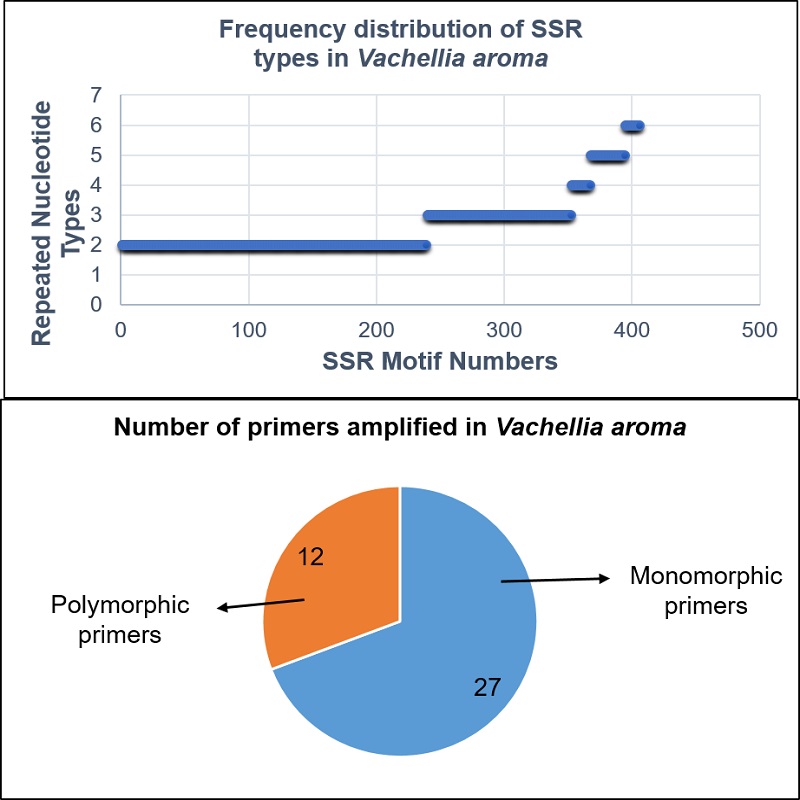Development of microsatellite markers for the American species Vachellia aroma (Fabac
DOI:
https://doi.org/10.31055/1851.2372.v59.n1.40763Palavras-chave:
454 pyrosequencing, polymorphic SSR, Vachellia aroma,, Vachellia cavenResumo
Background and aims: There are currently no microsatellite markers available for any American species of Vachellia, and particularly, for V. aroma. Then the aims of this study were to develop SSR markers specific for V. aroma, for the first time, and test its amplification in a close related species.
M&M: For the development of the SSR in V. aroma, total genomic DNA was extracted and it was sequenced in a one-fourth run on a Roche 454 GS FLX+ platform. The study area included two Argentinean populations: San José and Robles, Santiago del Estero province.
Results: We detected 422 sequences containing SSR loci. A set of 39 primer pairs presented amplified products in V. aroma and V. caven, but 12 revealed clear, replicable and polymorphic loci in V. aroma.
Conclusions: The results of this work indicate that a new set of SSR markers was developed for V. aroma and their transferability to V. caven was assessed. The analysis of variability, showed that these 12 polymorphic markers are highly informative, and a powerful tool to investigate population genetics parameters in V. aroma and related species.
Referências
ALONSO, J., & C. DESMARCHELIER. 2005. Plantas medicinales autóctonas de la Argentina. Bases científicas para su aplicación en atención primaria de la salud, pp. 136-139. Ed. L.O.L.A., Buenos Aires.
BOTSTEIN, D., R. D. WHITE, M. SKOLNICK, & R. W. DAVIS. 1980. Construction of a genetic linkage map in man using restriction fragment length polymorphisms. Am. J. Hum. Genet. 32: 314-331.
CARRIZO, E. DEL V., M. O. PALACIO, & L. D. ROIC (ex aequo). 2005. Uso medicinal de algunas especies nativas en Santiago del Estero (República Argentina). Dominguezia 21: 25-32.
CIALDELLA, A. M. 1984. El género Acacia (Leguminosae) en la Argentina. Darwiniana 25: 59-111.
CONTRERAS, R., F. S. CAREVIC, V. PORCILE & M. ARIAS. 2020. Development of SSR loci in Prosopis tamarugo Phillipi and assessment of their transferability to species of the Strombocarpa section. Forest Systems 29: 10.
DEL VALLE PEREA, M., G. PEDRAZA, & J. DEL VALLE LUCEROS. 2007. Relevamiento de la flora arbórea autóctona en la provincia de Catamarca, pp. 38-40. Consejo Federal de Inversiones, Buenos Aires.
DEMAIO, P., U.O. KARLIN, & M. MEDINA. 2002. Árboles nativos del centro de Argentina, Ed. L.O.L.A., Buenos Aires.
FAIRCLOTH, B. C. 2008. MSATCOMMANDER: Detection of microsatellite repeat arrays and automated, locus-specific primer design. Mol. Ecol. Resour. 8: 92-94. https://doi.org/10.1111/j.1471-8286.2007.01884.x
FERREIRA, M. A. J. da F. 2003. Utilizaçao das técnicas de marcadores moleculares na genética de populaçoes, na genética quantitativa e no melhoramento de plantas. Embrapa Roraima, Boa Vista.
JAHNKE, G., J. SMIDLA, & P. POCZAI. 2022. MolMarker: A Simple Tool for DNA Fingerprinting Studies and Polymorphic Information Content Calculation. Diversity (Basel) 14: 497. https://doi.org/10.3390/d14060497
MARTÍNEZ CROVETTO, R. 1981. Las plantas utilizadas en medicina popular en el noroeste de Corrientes. Miscelánea Fundación Miguel Lillo 69: 7-139.
NEI, M. 1978. Estimation of average heterozygosity and genetic distance from a small number of individuals. Genetics 89: 583-90.
PEAKALL, R., & P. E. SMOUSE. 2012. GenAlEx 6.5. Bioinformatics 28: 2537-2539. https://doi.org/10.1093/bioinformatics/bts460
POMETTI, C. L., B. PIZZO, M. BRUNETTI, N. MACCHIONI, … & B. O. SAIDMAN. 2009. Argentinean native woods species: Physical and mechanical characterization of some Prosopis species and Acacia aroma (Leguminosae; Mimosoideae). Bioresour. Technol. 100: 1999-2004. https://doi.org/10.1016/j.biortech.2008.09.061
POMETTI, C., C. BESSEGA, A. CIALDELLA, M. EWENS, … & J. VILARDI. 2018. Spatial genetic structure within populations and management implications of the South American species Acacia aroma (Fabaceae). Plos One 13: e0192107. https://doi.org/10.1371/journal.pone.0192107
ROZEN, S. & H. J. SKALETSKY. 2000. Primer3 on the WWW for general users and for biologist programmers. In: MISENER, S. & S. A. KRAWETZ (eds.), Methods in molecular biology, vol. 132: Bioinformatics methods and protocols, 365-386. Humana Press, Totowa, New Jersey. https://doi.org/10.1385/1-59259-192-2:365
WARDILL, T. J., K. D. SCOTT, G. C. GRAHAM, & M. P. ZALUCKI. 2004. Isolation and characterization of microsatellite loci from Acacia nilotica ssp. indica (Mimosaceae). Mol. Ecol. Notes 4: 361-363. https://doi.org/10.1111/j.1471-8286.2004.00697.x
WRIGHT, S. 1978. Evolution and the genetics of populations variability within and among natural populations, vol. 4. University of Chicago Press, Chicago.

Downloads
Publicado
Edição
Seção
Licença
Copyright (c) 2024 Carolina Luciana Pometti, Cecilia Bessega, Mauricio Ewens, Juan C. Vilardi, Beatriz O. Saidman

Este trabalho está licenciado sob uma licença Creative Commons Attribution-NonCommercial-NoDerivatives 4.0 International License.
Proporciona ACESSO ABERTO imediato e livre ao seu conteúdo sob o princípio de tornar a pesquisa livremente disponível ao público, o que promove uma maior troca de conhecimento global, permitindo que os autores mantenham seus direitos autorais sem restrições. 
Material publicado em Bol. Soc. Argent. Bot. é distribuído sob uma licença Creative Commons Attribution-NonCommercial-ShareAlike 4.0 International License. 




